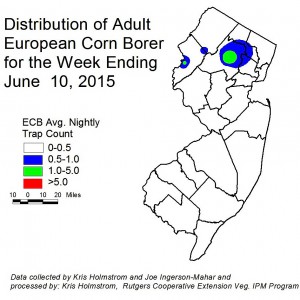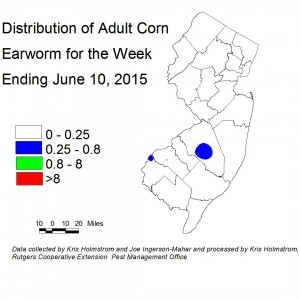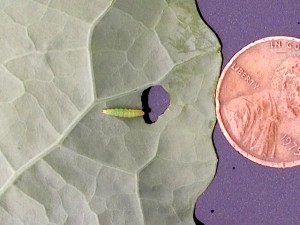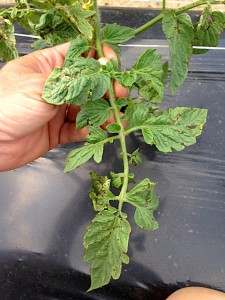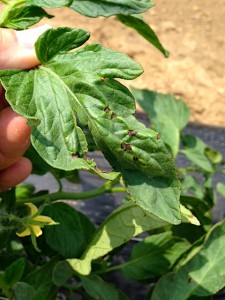Sweet Corn
Catches of European corn borer (ECB) are now in decline through much of the state. Remaining areas of highest activity include parts of Morris and Warren counties (see ECB map).
ECB infestations are now rising in sweet corn plantings. Feeding ranges from single digits to 12% in areas where IPM personnel are operating.
Be sure to begin monitoring plantings for ECB feeding while they are still in the whorl stage. Consider treating when the number of infested plants in a 50 plant sample exceeds 12%. Feeding in the whorl stage will appear as numerous small holes (called “shot-hole”) on leaves, with damage present on consecutively younger leaves. As plants progress to pre-tassel and beyond, the actual larvae may be found in or on the emerging tassels. Any planting remaining at or above threshold as it proceeds to full tassel should be treated, as this is the last stage at which ECB larvae will be exposed and vulnerable to insecticidal sprays.
Often, early sweet corn plantings suffer from “split set”, in which germination does not occur in a uniform fashion. The result is a planting where all plants do not reach full tassel at the same time. This situation may require an extra tassel spray if there are several days difference in the time full tassel is reached on a significant number of the plants.
Insecticides that are acceptable in organic production include the spinosyn based material Entrust (IRAC-5) and Dipel (IRAC-11a). The 10G formulation of Dipel is particularly useful when granules can be dropped or broadcast such that they get into the whorls of corn plants. See the 2015 Commercial Vegetable Recommendations Guide for more insecticide choices.
For more information see:
| The highest nightly ECB catches for the previous week are as follows: | ||
| Denville 3 | Clinton 1 | New Egypt 1 |
| Belvidere 2 | Crosswicks 1 | Newton 1 |
| Allamuchy 1 | Downer 1 | Pedricktown 1 |
| Blairstown 1 | Hackettstown 1 | South Branch 1 |
Several corn earworm moths (CEW) were captured in blacklights this past week. This adult activity has been recorded in central Burlington County and the western Salem-Gloucester border (see CEW map).
| The highest nightly CEW blacklight trap catches for the previous week are as follows: | |
| Downer 1 | Tabernacle 1 |
| Pedricktown 1 | Woodstown 1 |
| The highest nightly CEW pheromone trap catches for the previous week are as follows: | ||
| Springdale 3 | Elm 2 | East Vineland 1 |
| Beckett 2 | Woodstown 2 | |
For sinking sweet corn, the following spray schedules are warranted.
Silking Spray Schedules*:
South – 5-6 days
Central – 6 days
North – 6-7 days
Peppers
Young pepper plants are at risk of infestation from this first ECB generation. Be sure to scout fields regularly for the presence of ECB egg masses. If two or more egg masses are found in a 50 plant (two leaves/plant) sample, consider treating even if no fruit are present. In the absence of fruit, ECB larvae will bore into the central stem, topping the plant. This will result in the loss of crown fruit on infested plants. Generally, where blacklight trap catches average one or more ECB per night (blue and green areas on the ECB map) and fruit are greater than ½” in diameter, insecticides are warranted. See the 2015 Commercial Vegetable Production Recommendations for materials useful in controlling ECB.
Pepper Weevil Report
No pepper weevils have been trapped during the past week either at produce handling facilities or in fields. There are no known field infestations at this time. Hopefully, this trend continues. Since no weevils have been trapped there is no map for this week.
Cole Crops
Diamondback moth (DBM) infestations have become more common in cole crop plantings around the state, in addition to the increasing numbers of imported cabbage worms (ICW).
The presence of DBM does not alter the action thresholds for caterpillar pests in these crops, but it is important to avoid synthetic pyrethroid insecticides when dealing with DBM. Many populations are resistant to these chemicals.
Better choices include:
[active ingredient – trade name (IRAC* code)]:
Spinosad/Spinetoram – Entrust/ Radiant (5) – Entrust also OMRI approved.
Chlorantraniliprole – Coragen (28)
Cyantraniliprole – Exirel (28)
Flubendiamide – Synapse (28)
- Cole Crops Scouting Methods, Thresholds, and Notes
- Cole Crops Insect Pests: Diamondback Moth Larvae
- 2015 NJ Commercial Vegetable Production Recommendations
Brown Marmorated Stink Bug (BMSB)
No BMSB were captured in NJ blacklilght traps this week.
Tomatoes
Recent rains have resulted in the appearance of bacterial leaf spot (BLS) in several northern NJ tomato plantings. BLS appears as small, very dark lesions on young and older leaves, often causing some distortion where leaves were not fully expanded when the infection started (see photos – click to enlarge).
-
Bacterial leaf spot in Tomato
Photo: Kris Holmstrom
-
Bacterial leaf spot in Tomato
Photo: Kris Holmstrom
It is important to treat preventively for bacterial infections. Timing and rates for applications of copper and/or the plant defense activator Actigard are detailed in the 2015 Commercial Vegetable Production Recommendations. These products provide some suppression of bacterial pathogens. Pruning and tying of plants is on-going. Remember that any event that results in contact with the plant causes numerous injuries to them (this includes hail injury). While these injuries heal, they serve as avenues of entry for bacterial pathogens that may be present either on the plants or in the field. BLS can result in unmarketable fruit. It is critical that spread of bacterial organisms be limited as much as possible. Avoid working in fields when plants are wet. When work is to be done in more than one planting, always work from youngest to oldest plants. This prevents workers from transporting bacteria to younger plants, where infections can result in increased crop loss. Remember that the earlier a plant is infected by a bacterial pathogen, the more likely it is to produce unmarketable fruit.
